The
Android 2.3 platform introduces many new and exciting features for
users and developers. This document provides a glimpse at some of the
new features and technologies in Android 2.3. For detailed information
about the new developer APIs, see the Android 2.3 version notes.
New User Features
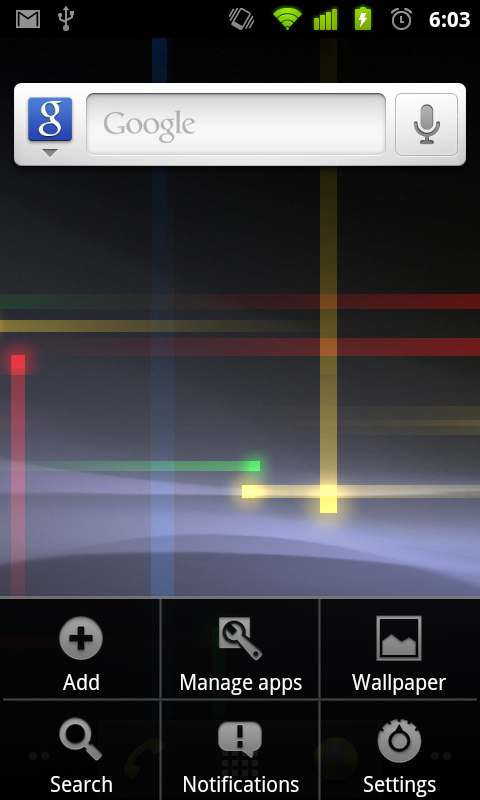
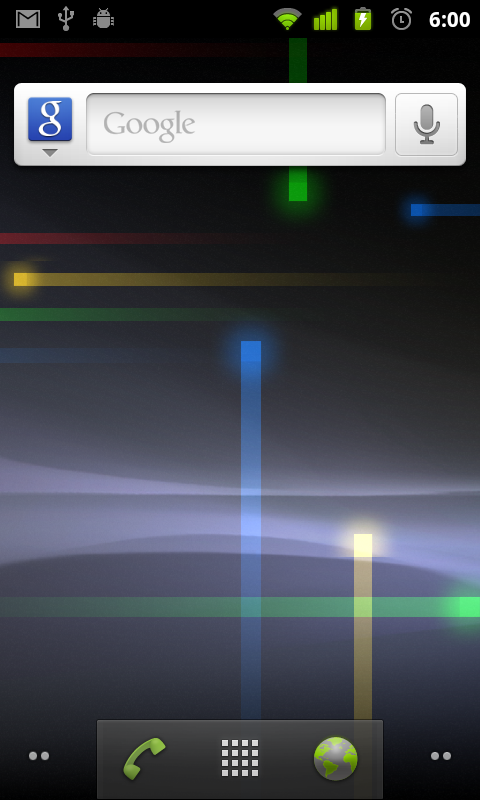
UI refinements for simplicity and speed
The
user interface is refined in many ways across the system, making it
easier to learn, faster to use, and more power-efficient. A simplified
visual theme of colors against black brings vividness and contrast to
the notification bar, menus, and other parts of the UI. Changes in menus
and settings make it easier for the user to navigate and control the
features of the system and device.
Faster, more intuitive text input
The
Android soft keyboard is redesigned and optimized for faster text input
and editing. The keys themselves are reshaped and repositioned for
improved targeting, making them easier to see and press accurately, even
at high speeds. The keyboard also displays the current character and
dictionary suggestions in a larger, more vivid style that is easier to
read.
The
keyboard adds the capability to correct entered words from suggestions
in the dictionary. As the user selects a word already entered, the
keyboard displays suggestions that the user can choose from, to replace
the selection. The user can also switch to voice input mode to replace
the selection. Smart suggestions let the user accept a suggestion and
then return to correct it later, if needed, from the original set of
suggestions.
New multitouch key-chording lets the user quickly enter numbers and symbols by pressing Shift+<letter> and ?123+<symbol>,
without needing to manually switch input modes. From certain keys,
users can also access a popup menu of accented characters, numbers, and
symbols by holding the key and sliding to select a character.

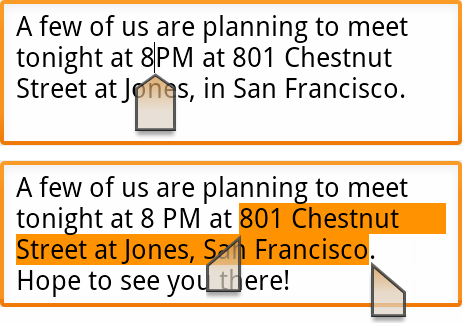
One-touch word selection and copy/paste
When
entering text or viewing a web page, the user can quickly select a word
by press-hold, then copy to the clipboard and paste. Pressing on a word
enters a free-selection mode — the user can adjust the selection area
as needed by dragging a set of bounding arrows to new positions, then
copy the bounded area by pressing anywhere in the selection area. For
text entry, the user can slide-press to enter a cursor mode, then
reposition the cursor easily and accurately by dragging the cursor
arrow. With both the selection and cursor modes, no use of a trackball
is needed.
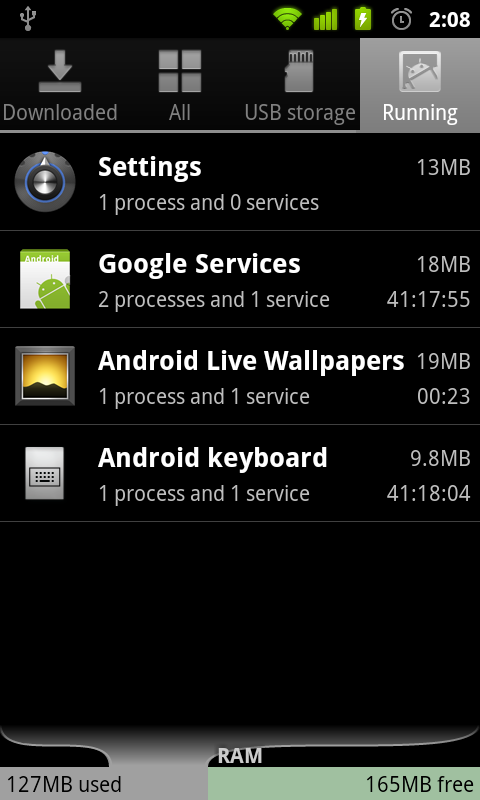
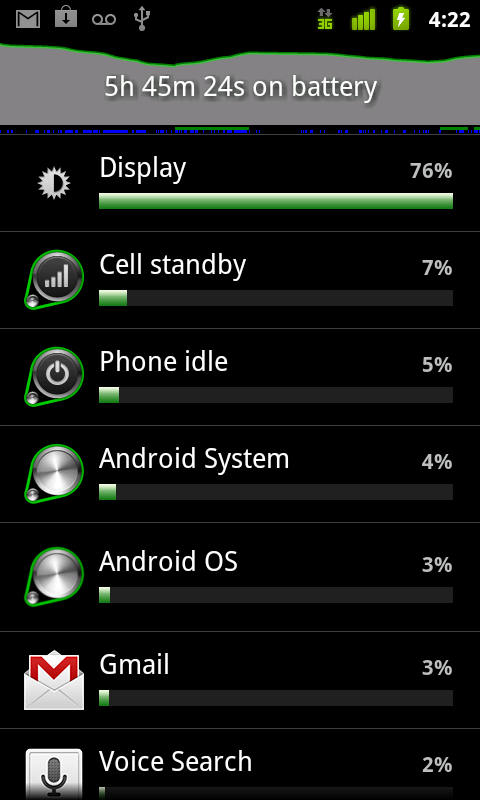
Improved power management
The
Android system takes a more active role in managing apps that are
keeping the device awake for too long or that are consuming CPU while
running in the background. By managing such apps — closing them if
appropriate — the system helps ensure best possible performance and
maximum battery life.
The
system also gives the user more visibility over the power being
consumed by system components and running apps. The Application settings
provides an accurate overview of how the battery is being used, with
details of the usage and relative power consumed by each component or
application.
Control over applications
A
shortcut to the Manage Applications control now appears in the Options
Menu in the Home screen and Launcher, making it much easier to check and
manage application activity. Once the user enters Manage Applications, a
new Running tab displays a list of active applications and the storage
and memory being used by each. The user can read further details about
each application and if necessary stop an application or report feedback
to its developer.
New ways of communicating, organizing
An updated set of standard applications lets the user take new approaches to managing information and relationships.

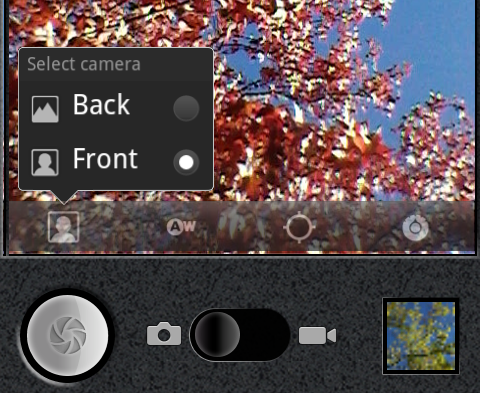
Internet calling
The
user can make voice calls over the internet to other users who have SIP
accounts. The user can add an internet calling number (a SIP address)
to any Contact and can initiate a call from Quick Contact or Dialer. To
use internet calling, the user must create an account at the SIP
provider of their choice — SIP accounts are not provided as part of the
internet calling feature. Additionally, support for the platform's SIP
and internet calling features on specific devices is determined by their
manufacturers and associated carriers.

Near-field communications
An
NFC Reader application lets the user read and interact with near-field
communication (NFC) tags. For example, the user can “touch” or “swipe”
an NFC tag that might be embedded in a poster, sticker, or
advertisement, then act on the data read from the tag. A typical use
would be to read a tag at a restaurant, store, or event and then rate or
register by jumping to a web site whose URL is included in the tag
data. NFC communication relies on wireless technology in the device
hardware, so support for the platform's NFC features on specific devices
is determined by their manufacturers.
Downloads management
The
Downloads application gives the user easy access to any file downloaded
from the browser, email, or another application. Downloads is built on
an completely new download manager facility in the system that any other
applications can use, to more easily manage and store their downloads.
Camera
The application now lets the user access multiple cameras on the device, including a front-facing camera, if available.
New Developer Features
Android 2.3 delivers a variety of features and APIs that let developers bring new types of applications to the Android platform.
Enhancements for gaming
Performance
Android
2.3 includes a variety of improvements across the system that make
common operations faster and more efficient for all applications. Of
particular interest to game developers are:
- Concurrent garbage collector — The Dalivik VM introduces a new, concurrent garbage collector that minimizes application pauses, helping to ensure smoother animation and increased responsiveness in games and similar applications.
- Faster event distribution — The plaform now handles touch and keyboard events faster and more efficiently, minimizing CPU utilization during event distribution. The changes improve responsiveness for all applications, but especially benefit games that use touch events in combination with 3D graphics or other CPU-intensive operations.
- Updated video drivers — The platform uses updated third-party video drivers that improve the efficiency of OpenGL ES operations, for faster overall 3D graphics performance.
Native input and sensor events
Applications
that use native code can now receive and process input and sensor
events directly in their native code, which dramatically improves
efficiency and responsiveness.
Native
libraries exposed by the platform let applications handle the same
types of input events as those available through the framework.
Applications can receive events from all supported sensor types and can
enable/disable specific sensors and manage event delivery rate and
queueing.
Gyroscope and other new sensors, for improved 3D motion processing
Android
2.3 adds API support for several new sensor types, including gyroscope,
rotation vector, linear acceleration, gravity, and barometer sensors.
Applications can use the new sensors in combination with any other
sensors available on the device, to track three-dimensional device
motion and orientation change with high precision and accuracy. For
example, a game application could use readings from a gyroscope and
accelerometer on the device to recognize complex user gestures and
motions, such as tilt, spin, thrust, and slice.
Open API for native audio
The platform provides a software implementation of Khronos OpenSL ES,
a standard API that gives applications access to powerful audio
controls and effects from native code. Applications can use the API to
manage audio devices and control audio input, output, and processing
directly from native code.
Native graphics management
The platform provides an interface to its Khronos EGL library,
which lets applications manage graphics contexts and create and manage
OpenGL ES textures and surfaces from native code.
Native access to Activity lifecycle, window management
Native applications can declare a new type of Activity class,
NativeActivity whose lifecycle callbacks are implemented directly in native code. The NativeActivity and
its underlying native code run in the system just as do other
Activities — they run in the application's system process and execute on
the application's main UI thread, and they receive the same lifecycle
callbacks as do other Activities.
The
platform also exposes native APIs for managing windows, including the
ability to lock/unlock the pixel buffer to draw directly into it.
Through the API, applications can obtain a native window object
associated with a framework Surface object and interact with it directly
in native code.
Native access to assets, storage
Applications
can now access a native Asset Manager API to retrieve application
assets directly from native code without needing to go through JNI. If
the assets are compressed, the platform does streaming decompression as
the application reads the asset data. There is no longer a limit on the
size of compressed
.apk assets that can be read.
Additionally,
applications can access a native Storage Manager API to work directly
with OBB files downloaded and managed by the system. Note that although
platform support for OBB is available in Android 2.3, development tools
for creating and managing OBB files will not be available until early
2011.
Robust native development environment
The
Android NDK (r5 or higher) provides a complete set of tools,
toolchains, and libraries for developing applications that use the rich
native environment offered by the Android 2.3 platform. For more
information or to download the NDK, please see the Android NDK page.
New forms of communication
Internet telephony
Developers
can now add SIP-based internet telephony features to their
applications. Android 2.3 includes a full SIP protocol stack and
integrated call management services that let applications easily set up
outgoing and incoming voice calls, without having to manage sessions,
transport-level communication, or audio record or playback directly.
Support
for the platform's SIP and internet calling features on specific
devices is determined by their manufacturers and associated carriers.
Near Field Communications (NFC)
The
platform's support for Near Field Communications (NFC) lets developers
get started creating a whole new class of applications for Android.
Developers can create new applications that offer proximity-based
information and services to users, organizations, merchants, and
advertisers.
Using
the NFC API, applications can read and respond to NFC tags “discovered”
as the user “touches” an NFC-enabled device to elements embedded in
stickers, smart posters, and even other devices. When a tag of interest
is collected, applications can respond to the tag, read messages from
it, and then store the messages, prompting the user as needed.
Starting from Android 2.3.3, applications can also write to tags and set up peer-to-peer connections with other NFC devices.
NFC
communication relies on wireless technology in the device hardware, so
support for the platform's NFC features on specific devices is
determined by their manufacturers.
Rich multimedia
Mixable audio effects
A
new audio effects API lets developers easily create rich audio
environments by adding equalization, bass boost, headphone
virtualization (widened soundstage), and reverb to audio tracks and
sounds. Developers can mix multiple audio effects in a local track or
apply effects globally, across multiple tracks.
Support for new media formats
The
platform now offers built-in support for the VP8 open video compression
format and the WebM open container format. The platform also adds
support for AAC encoding and AMR wideband encoding (in software), so
that applications can capture higher quality audio than narrowband.
Access to multiple cameras
The
Camera API now lets developers access any cameras that are available on
a device, including a front-facing camera. Applications can query the
platform for the number of cameras on the device and their types and
characteristics, then open the camera needed. For example, a video chat
application might want to access a front-facing camera that offers
lower-resolution, while a photo application might prefer a back-facing
camera that offers higher-resolution.
New Platform Technologies
Media Framework
- New media framework fully replaces OpenCore, maintaining all previous codec/container support for encoding and decoding.
- Integrated support for the VP8 open video compression format and the WebM open container format
- Adds AAC encoding and AMR wideband encoding
Linux Kernel
- Upgraded to 2.6.35
Networking
- SIP stack, configurable by device manufacturer
- Support for Near Field Communications (NFC), configurable by device manufacturer
- Updated BlueZ stack
Dalvik runtime
- Dalvik VM:
- Concurrent garbage collector (target sub-3ms pauses)
- Adds further JIT (code-generation) optimizations
- Improved code verification
- StrictMode debugging, for identifying performance and memory issues
- Core libraries:
- Expanded I18N support (full worldwide encodings, more locales)
- Faster Formatter and number formatting. For example, float formatting is 2.5x faster.
- HTTP responses are gzipped by default. XML and JSON API response sizes may be reduced by 60% or more.
- New collections and utilities APIs
- Improved network APIs
- Improved file read and write controls
- Updated JDBC
- Updates from upstream projects:
- OpenSSL 1.0.0a
- BouncyCastle 1.45
- ICU 4.4
- zlib 1.2.5
For more information about the new developer APIs, see the Android 2.3 version notes and the API Differences Report.
 Unknown
Unknown


